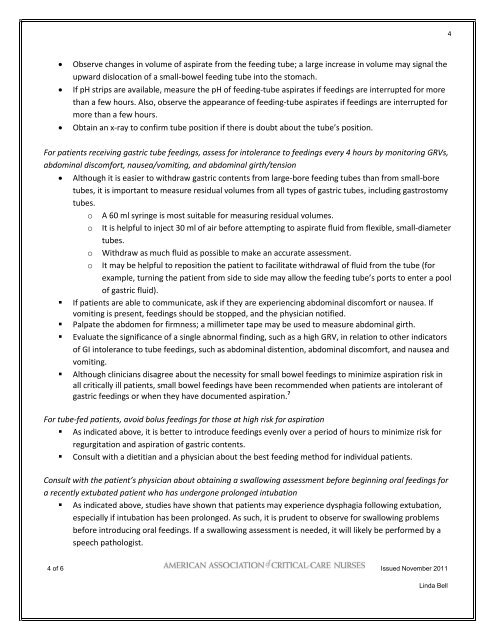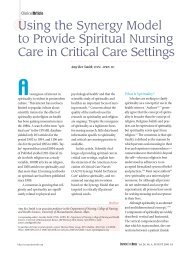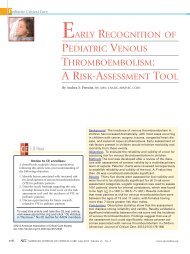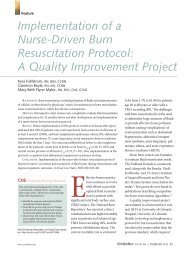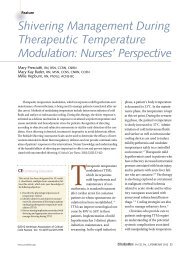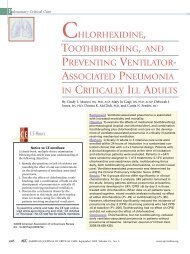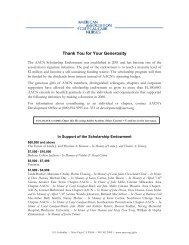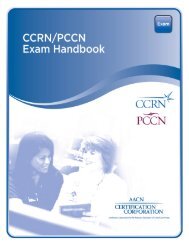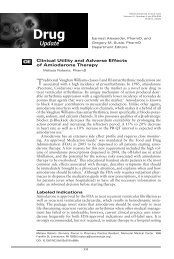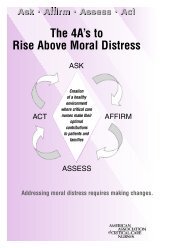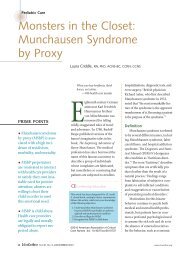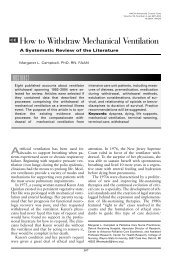Prevention of Aspiration Practice Alert - American Association of ...
Prevention of Aspiration Practice Alert - American Association of ...
Prevention of Aspiration Practice Alert - American Association of ...
You also want an ePaper? Increase the reach of your titles
YUMPU automatically turns print PDFs into web optimized ePapers that Google loves.
Observe changes in volume <strong>of</strong> aspirate from the feeding tube; a large increase in volume may signal the<br />
upward dislocation <strong>of</strong> a small-bowel feeding tube into the stomach.<br />
If pH strips are available, measure the pH <strong>of</strong> feeding-tube aspirates if feedings are interrupted for more<br />
than a few hours. Also, observe the appearance <strong>of</strong> feeding-tube aspirates if feedings are interrupted for<br />
more than a few hours.<br />
Obtain an x-ray to confirm tube position if there is doubt about the tube’s position.<br />
For patients receiving gastric tube feedings, assess for intolerance to feedings every 4 hours by monitoring GRVs,<br />
abdominal discomfort, nausea/vomiting, and abdominal girth/tension<br />
Although it is easier to withdraw gastric contents from large-bore feeding tubes than from small-bore<br />
tubes, it is important to measure residual volumes from all types <strong>of</strong> gastric tubes, including gastrostomy<br />
tubes.<br />
o A 60 ml syringe is most suitable for measuring residual volumes.<br />
o It is helpful to inject 30 ml <strong>of</strong> air before attempting to aspirate fluid from flexible, small-diameter<br />
tubes.<br />
o Withdraw as much fluid as possible to make an accurate assessment.<br />
o It may be helpful to reposition the patient to facilitate withdrawal <strong>of</strong> fluid from the tube (for<br />
example, turning the patient from side to side may allow the feeding tube’s ports to enter a pool<br />
<strong>of</strong> gastric fluid).<br />
If patients are able to communicate, ask if they are experiencing abdominal discomfort or nausea. If<br />
vomiting is present, feedings should be stopped, and the physician notified.<br />
Palpate the abdomen for firmness; a millimeter tape may be used to measure abdominal girth.<br />
Evaluate the significance <strong>of</strong> a single abnormal finding, such as a high GRV, in relation to other indicators<br />
<strong>of</strong> GI intolerance to tube feedings, such as abdominal distention, abdominal discomfort, and nausea and<br />
vomiting.<br />
Although clinicians disagree about the necessity for small bowel feedings to minimize aspiration risk in<br />
all critically ill patients, small bowel feedings have been recommended when patients are intolerant <strong>of</strong><br />
gastric feedings or when they have documented aspiration. 7<br />
For tube-fed patients, avoid bolus feedings for those at high risk for aspiration<br />
As indicated above, it is better to introduce feedings evenly over a period <strong>of</strong> hours to minimize risk for<br />
regurgitation and aspiration <strong>of</strong> gastric contents.<br />
Consult with a dietitian and a physician about the best feeding method for individual patients.<br />
Consult with the patient’s physician about obtaining a swallowing assessment before beginning oral feedings for<br />
a recently extubated patient who has undergone prolonged intubation<br />
As indicated above, studies have shown that patients may experience dysphagia following extubation,<br />
especially if intubation has been prolonged. As such, it is prudent to observe for swallowing problems<br />
before introducing oral feedings. If a swallowing assessment is needed, it will likely be performed by a<br />
speech pathologist.<br />
4 <strong>of</strong> 6 Issued November 2011<br />
Linda Bell<br />
4


